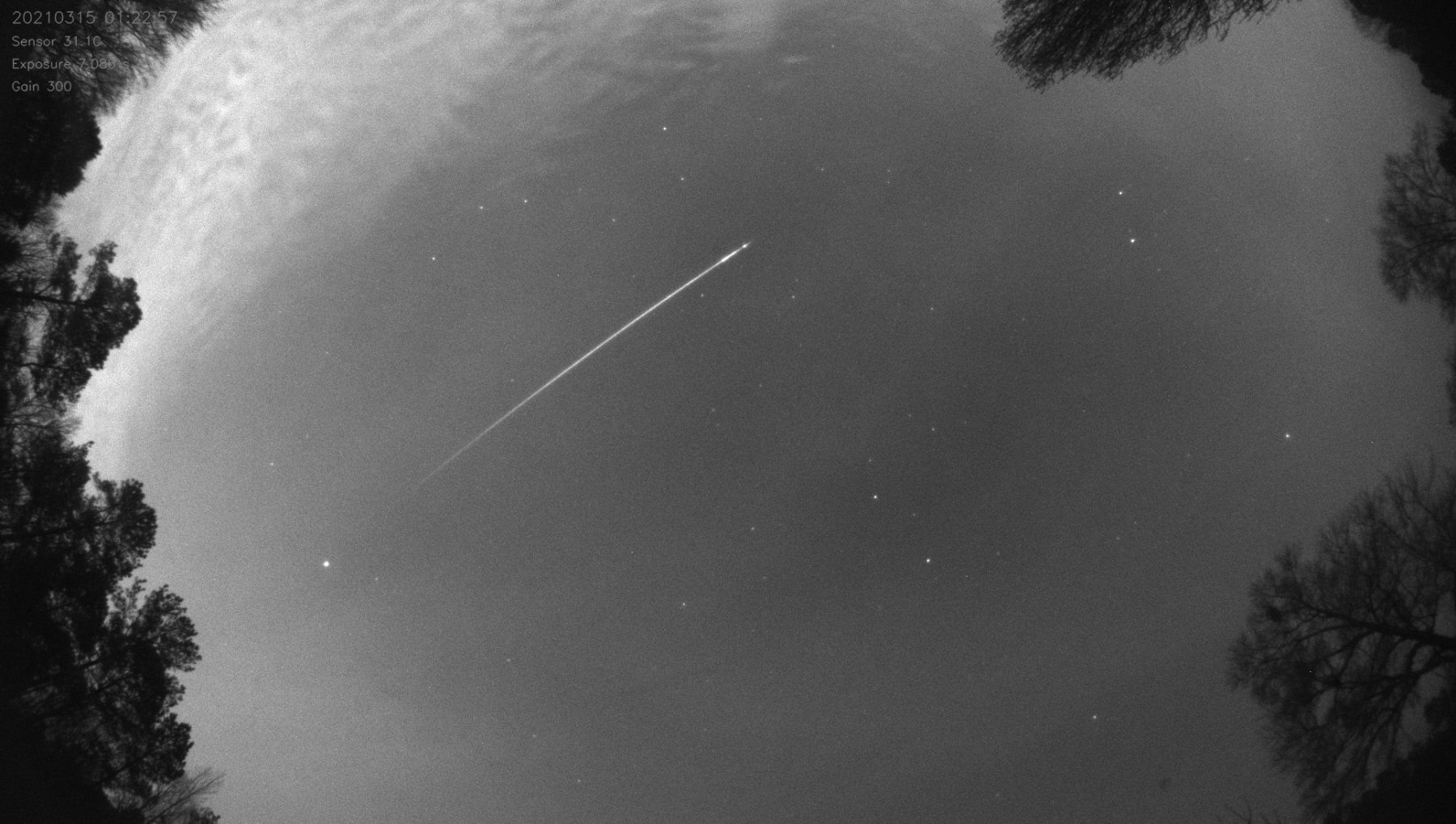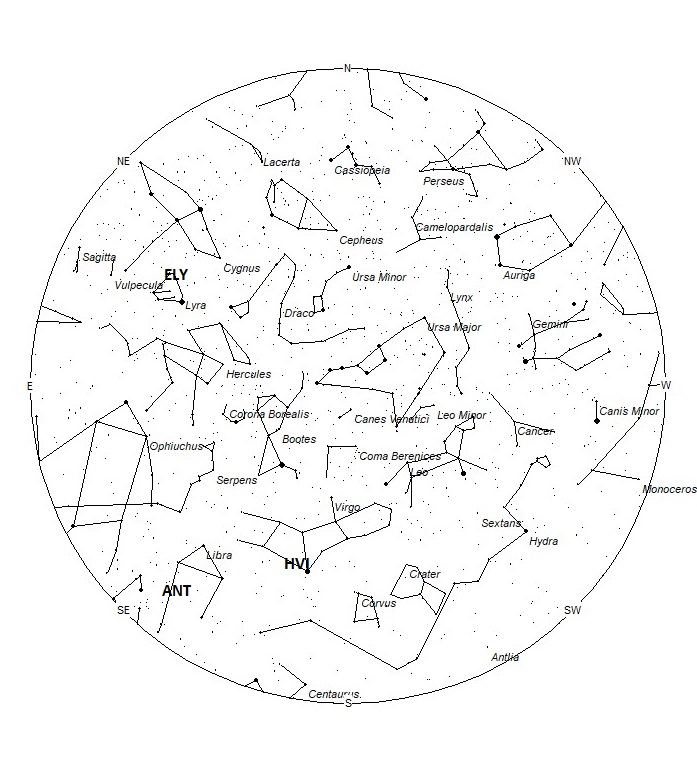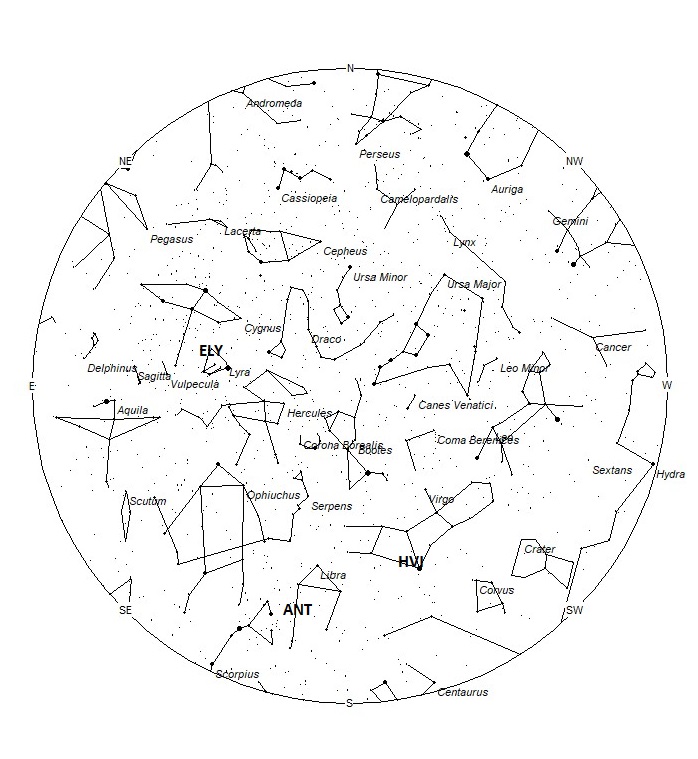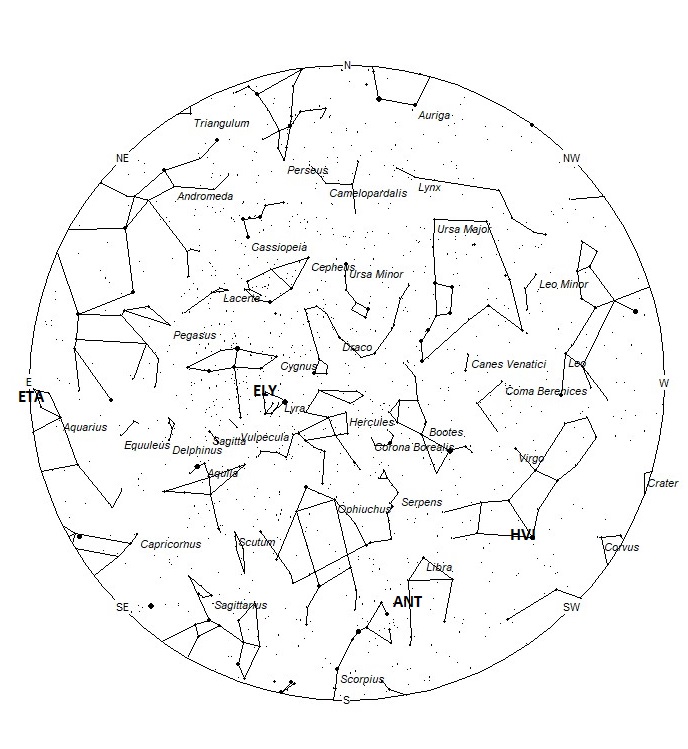 Aaron Morris captured this fireball on 15 March 2021 from Griffin, Georgia, USA. It starts near the bright star Arcturus (alpha Bootis) and passes south of the “Big Dipper” (Ursa Major) as it shoots westward.
Aaron Morris captured this fireball on 15 March 2021 from Griffin, Georgia, USA. It starts near the bright star Arcturus (alpha Bootis) and passes south of the “Big Dipper” (Ursa Major) as it shoots westward.May is the best spring month (in the northern hemisphere) to view meteor activity. The eta Aquariids are very active the first two weeks of the month then fade as the month progresses. These meteors are only visible in the few dark hours prior to dawn. The remainder of the night has low meteor rates. The only other showers of note this month are the eta Lyrids and the Anthelion radiant. These will add only 2-3 meteors per hour to the total count. Sporadic rates are low but steady as seen from the mid-northern hemisphere (45 N). Sporadic rates seen from the tropical southern latitudes (25 S) are strong and remain so the entire month.
During this period the moon reaches its last quarter phase on Monday May 3rd. On this date the moon is located 90 degrees west of the sun and rises near 3:00 local summer time (LST). This weekend the waning gibbous moon will rise during the early morning hours and will spoil any observing attempts once it has risen. As the moon reaches its last quarter phase, the glare will not be so bad and successful meteor observations can be conducted if you keep the moon out of your field of view. The estimated total hourly meteor rates for evening observers this week is near 2 as seen from mid-northern latitudes (45N) and 3 as seen from tropical southern locations (25S). For morning observers, the estimated total hourly rates should be near 9 as seen from mid-northern latitudes (45N) and 14 as seen from tropical southern locations (25S). The actual rates will also depend on factors such as personal light and motion perception, local weather conditions, alertness, and experience in watching meteor activity. Morning rates are reduced during this period due to moonlight. Note that the hourly rates listed below are estimates as viewed from dark sky sites away from urban light sources. Observers viewing from urban areas will see less activity as only the brighter meteors will be visible from such locations.
The radiant (the area of the sky where meteors appear to shoot from) positions and rates listed below are exact for Saturday night/Sunday morning May 1/2. These positions do not change greatly day to day so the listed coordinates may be used during this entire period. Most star atlases (available at science stores and planetariums) will provide maps with grid lines of the celestial coordinates so that you may find out exactly where these positions are located in the sky. A planisphere or computer planetarium program is also useful in showing the sky at any time of night on any date of the year. Activity from each radiant is best seen when it is positioned highest in the sky, either due north or south along the meridian, depending on your latitude. It must be remembered that meteor activity is rarely seen at the radiant position. Rather they shoot outwards from the radiant, so it is best to center your field of view so that the radiant lies at the edge and not the center. Viewing there will allow you to easily trace the path of each meteor back to the radiant (if it is a shower member) or in another direction if it is sporadic. Meteor activity is not seen from radiants that are located far below the horizon. The positions below are listed in a west to east manner in order of right ascension (celestial longitude). The positions listed first are located further west therefore are accessible earlier in the night while those listed further down the list rise later in the night.
These sources of meteoric activity are expected to be active this week.
.
The last of the h Virginids (HVI) are expected to be seen this week. These meteors are active from April 20-May 04 with maximum activity predicted on May 1st. The radiant is currently located at 13:36 (204) -12. This area of the sky is located in southern Virgo, 2 degrees east of the 1st magnitude star known as Spica (alpha Virginis). This area of the sky is best seen near midnight local summer time (LST), when it is located highest in the sky. No matter your location, rates are expected to be less than 1 per hour. At 17km/sec. these meteors would produce meteors of very slow velocity.
The center of the large Anthelion (ANT) radiant is currently located at 15:36 (234) -15. This position lies in eastern Libra, 5 degrees south of the 4th magnitude star known as Zubenelhakrabi (gamma Librae A). Due to the large size of this radiant, Anthelion activity may also appear from western Scorpius as well as Libra. This radiant is best placed near 0200 LST, when it lies on the meridian and is located highest in the sky. Rates at this time should be near 1 per hour as seen from the Northern Hemisphere and 2 per hour as seen from south of the equator. With an entry velocity of 30 km/sec., the average Anthelion meteor would be of slow velocity.
The eta Lyrids (ELY) are active from May 6-15 with maximum activity occurring on the 10th. The radiant is currently located at 19:16 (289) +40. This area of the sky is located in northeastern Lyra, 1 degree north of the 4th magnitude star known as eta Lyrae. The radiant is also located 6 degrees northeast of the brilliant zero magnitude star known as Vega (alpha Lyrae). This radiant is best placed during the last hour before dawn when it lies highest above the horizon in a dark sky. Current rates are expected to be less than 1 no matter your location. These meteors are not well seen from locations south of the equator as the radiant does not rise very high into the northern sky. With an entry velocity of 40 km/sec., the average meteor from this source would be of medium velocity.
The eta Aquariids (ETA) reach maximum activity on the morning of May 5th when the radiant is located at 22:30 (338) -01. This area of the sky is located in northeastern Aquarius, 1 degree south of the 4th magnitude star known as zeta Aquarii. These meteors are not visible prior to 0100 LST and are best seen just before the start of dawn when the radiant lies highest in a dark sky. Hourly rates at maximum are expected to range from 20 as seen from the southern tropics to near zero as seen from high northern latitudes. With an entry velocity of 65 km/sec., the average meteor from this source would be of swift velocity.
As seen from the mid-northern hemisphere (45N) one would expect to see approximately 4 sporadic meteors per hour during the last hour before dawn as seen from rural observing sites. Evening rates would be near 2 per hour. As seen from the tropical southern latitudes (25S), morning rates would be near 7 per hour as seen from rural observing sites and 3 per hour during the evening hours. Locations between these two extremes would see activity between the listed figures.
The list below offers the information from above in tabular form. Rates and positions are exact for Saturday night/Sunday morning except where noted in the shower descriptions.
| SHOWER | DATE OF MAXIMUM ACTIVITY | CELESTIAL POSITION | ENTRY VELOCITY | CULMINATION | HOURLY RATE | CLASS |
| RA (RA in Deg.) DEC | Km/Sec | Local Summer Time | North-South | |||
| h Virginids (HVI) | May 01 | 13:36 (204) -12 | 17 | 00:00 | <1 – <1 | IV |
| Anthelion (ANT) | – | 15:36 (234) -15 | 30 | 02:00 | 1 – 2 | II |
| eta Lyrids (ELY) | May 10 | 19:16 (289) +40 | 40 | 06:00 | <1 – <1 | II |
| eta Aquariids (ETA) | May 05 | 22:30 (338) -01 | 65 | 09:00 | 2 – 5 | I |







 You saw something bright and fast? Like a huge shooting star? Report it: it may be a fireball.
You saw something bright and fast? Like a huge shooting star? Report it: it may be a fireball.  You counted meteors last night? Share your results with us!
You counted meteors last night? Share your results with us!  You took a photo of a meteor or fireball? You have a screenshot of your cam? Share it with us!
You took a photo of a meteor or fireball? You have a screenshot of your cam? Share it with us!  You caught a meteor or fireball on video? Share your video with us!
You caught a meteor or fireball on video? Share your video with us!
4 comments
On this website the ETA maximum is indicated for early morning of May 5th but in the IMO Meteor Calender for early morning of May 6th. How comes this difference?
Peter, I am wondering the same. I’m hoping you received a private response & are able to provide clarification. My fingers are crossed the maximum ETA will in actuality be the morning of Thursday, May 6.
Peter and All,
These things happen when you have more than one person writing articles or making lists. We try to double check each other but this one slipped by us. Luckily, the eta Aquariids have a plateau-like maximum and there is not much difference between the two nights. We will try and prevent this from happening again!
One doesn’t have to visually see the meteors to know when they’re there. For several years now I have been going to rare locations for the Amateur Radio hobby. I use a computer program called WSJT-X and hooked to my 50 megacycle radio and 80 watts of power and a small antenna and for the May 5th Eta Aquarids on May 5th made 35 contacts off meteors. One needs to get out of bed early as best results seem to be in the few hours before and few hours after sunrise. I’m in Arnold, Nebraska, grid square DN91 and will try meteors again in the morning.